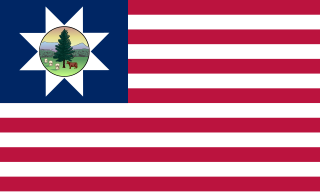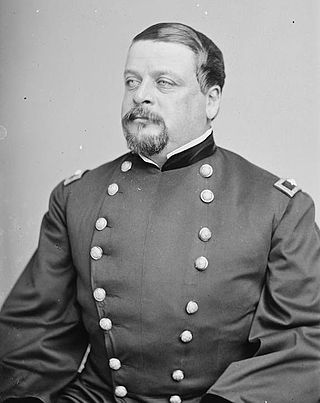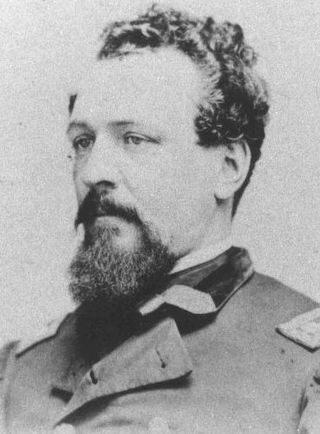Daniel Woodall (June 1, 1841 – August 2, 1880) was an American Union army officer during the period of the American Civil War. He served in the 1st Delaware Infantry Regiment, and fought in the Eastern Theater.
Daniel Woodall was born on June 1, 1841, in Dover, Delaware. Woodall worked as a civil engineer when the American Civil War erupted. Volunteering for the 1st Delaware Infantry Regiment, a volunteer unit mustered for 3 months of service in early 1861, he was commissioned a second lieutenant of Company H. [1] When the regiment's enlistment term ended in August it was rebuilt in Wilmington for a service time of 3 years. As the regimental officers were to be appointed again Woodall was named Captain of Company F on September 28, 1861. [2] The regiment was assigned to the II Corps of the Army of the Potomac; for service in the Eastern Theater. Leading his men into the Battle of Antietam on September 17, 1862, Woodall was shot in the arm. [3] After the Battle of Fredericksburg Woodall was promoted to major on December 30, 1862. [2]
In the Battle of Chancellorsville on May 3, 1863, Woodall was wounded again, this time by an artillery shell hitting his left leg calf. [4] Being on convalescence leave until late July he missed the Battle of Gettysburg. On July 30, 1863 Woodall was detached from the regiment and temporarily took command of the 39th New York Infantry Regiment that was attached to the same brigade. [5] At the Battle of Bristoe Station Major Woodall, serving with his Delawarians again, led half of the regiment as brigade skirmishers and was praised by his brigade (and regiment) commander, Colonel Thomas Alfred Smyth. [6]
Woodall was promoted to lieutenant colonel on November 5, 1863 and led the regiment into the Mine Run Campaign. [2] On court martial duty in February 1864, he returned to fight in the Battle of the Wilderness and the Battle of Spotsylvania Courthouse. He was shot through the foot at Spotsylvania but returned to command his regiment during the Battle of Cold Harbor and the Siege of Petersburg.
When Smyth was promoted to brigadier general Woodall became colonel of the 1st Delaware, which he actually commanded for nearly a year already; and he was promoted on December 23, 1864. [2] He was in brigade command during parts of the Appomattox Campaign. He was mustered out of the volunteers with his regiment on July 12. [2] At this time Woodall was one of the only four original officers from 1861 still serving with the regiment. [7]
On January 13, 1866, President Andrew Johnson nominated Wildrick for appointment to the grade of brevet brigadier general of volunteers for gallant and meritorious service in the War, to rank from June 15, 1865, and the United States Senate confirmed the appointment on March 12, 1866. [8]
After the war Woodall moved to Williamsburg, Virginia, where he was appointed as district assessor for the Internal Revenue Service. When the office was abolished in 1872 he became a farmer. On August 2, 1880, aged just 39, he died unexpectedly on his farm. Woodall was buried on Old Drawyers Presbyterian Churchyard at Odessa, Delaware. [9] [2]

John Cleveland Robinson was an American soldier in the United States Army. Robinson had a long and distinguished military career, fighting in many wars and culminating his career as a brigadier general and brevet major general in the Union Army during the American Civil War.

The 2nd Vermont Infantry Regiment was a three years' infantry regiment in the Union Army during the American Civil War. It served in the eastern theater, predominantly in the VI Corps, Army of the Potomac, from June 1861 to July 1865. It was a member of the famous Vermont Brigade.

Asa Peabody Blunt was an officer in the Union Army during the American Civil War. He remained on active duty after the war. In recognition of his service during the Civil War, he was appointed to the grade of brevet brigadier general of volunteers. Blunt was notable as commander of the 2nd Vermont Brigade and the United States Disciplinary Barracks at Fort Leavenworth, Kansas.

Gershom Mott was a United States Army officer and a General in the Union Army, a commander in the Eastern Theater of the American Civil War.

James Meech Warner was a New England manufacturer and a brevet brigadier general in the Union Army during the American Civil War.
The 17th Wisconsin Infantry Regiment was an infantry regiment that served in the Union Army during the American Civil War. It was popularly known as the Irish Brigade, due to its composition of mostly Irish American immigrants.

Alfred Gibbs was a career officer in the United States Army who served as an officer during the Mexican-American War and Apache Wars. He served as a brigadier general in the Union Army during the American Civil War.
The 1st Delaware Infantry Regiment, later known as the 1st Delaware Veteran Infantry Regiment was a United States volunteer infantry regiment raised for Union Army service in the American Civil War. Part of the II Corps it served in the Eastern Theater of the American Civil War.

St. Clair Augustine Mulholland was a colonel in the Union Army in the American Civil War who later received the brevets of brigadier general of volunteers and major general of volunteers and the Medal of Honor for gallantry in action at the Battle of Chancellorsville.

Samuel Beatty was an American soldier, sheriff, and farmer from Ohio. He was a brigadier general in the Union Army during the American Civil War. In 1866, he was awarded the brevet grade of major general of volunteers.

William Root Brewster was an officer in the Union Army during the American Civil War who commanded a regiment in the famed Excelsior Brigade of the Army of the Potomac. He later commanded the brigade, including at the Battle of Gettysburg where Brewster and his men were overrun by Confederates while defending the Emmitsburg Road position of the III Corps not far from the Peach Orchard.

Robert Ogden Tyler was an American military officer in the Union Army during the American Civil War. He graduated from the United States Military Academy in 1853 and fought in the Yakima War and the Utah War. He commanded the Artillery Reserve in the Army of the Potomac at the Battle of Gettysburg in July 1863, where his artillery batteries played an important role in the Union victory. Tyler also led a division of heavy artillery turned infantry during the Overland Campaign in 1864. He was severely wounded at the Battle of Cold Harbor and served in administrative duties for the remainder of the war.

Thomas Scott Allen was an American printer, teacher, newspaper publisher, and politician. He served as the 9th Secretary of State of Wisconsin and served as a Union Army officer throughout the American Civil War, earning an honorary brevet rank of brigadier general. Before the war he also served a term in the Wisconsin State Assembly, representing Iowa County, and later in life he was publisher of the Oshkosh Northwestern newspaper.

John E. Bendix was an officer in the Union Army during the American Civil War who commanded two different New York regiments and then a brigade of infantry in Army of the Potomac in the Eastern Theater. He survived a serious wound at the Battle of Fredericksburg in December 1862. He was noted as a prolific recruiter and organizer, and after the war, as a brevet general in the New York Militia, he helped organize the reconstruction era the New York state militia that later became the New York Guard. Bendix was mustered out of the Union Army on May 7, 1863. In July 1866, he was nominated and confirmed for appointment to the grade of brevet brigadier general of volunteers, to rank from March 13, 1865.

John Irvin Curtin was a cousin of Pennsylvania governor Andrew Gregg Curtin. He led a regiment and then a brigade in the American Civil War.
George Perkins Hawkes was a colonel in the Union Army during the American Civil War. He commanded the 21st Regiment Massachusetts Volunteer Infantry from April 1863 to July 1864. In March 1867, he was awarded the honorary grade of brevet brigadier general, United States Volunteers, to rank from March 13, 1865, seven months after his resignation of his commission in the army.

Oliver Edwards was a machine company executive, an inventor, and a volunteer officer in the Union Army during the American Civil War.
Joseph Nelson Garland Whistler was a career United States Army officer. He served in the Mexican–American War and received a brevet appointment for distinguished service in the Battle of Contreras and the Battle of Churubusco. At the beginning of the American Civil War, Whistler was among the U.S. Regular Army officers taken prisoner by Confederates in Texas in April 1861 and paroled but was not exchanged until August 15, 1862. In 1863, he became colonel of the 2nd New York Heavy Artillery Regiment. He received a promotion and four brevet appointments in the regular army for his service during the Overland Campaign, specifically the Battle of North Anna, and the Siege of Petersburg, specifically the Second Battle of Petersburg. He was nominated on January 13, 1866 and confirmed on March 12, 1866 for appointment to the grade of brevet brigadier general of volunteers, to rank from March 13, 1866. He retired in on October 19, 1886 as colonel of the 15th U.S. Infantry Regiment.

James Gwyn was an officer in the Union Army during the American Civil War. He immigrated at a young age from Ireland in 1846, initially working as a storekeeper in Philadelphia and later as a clerk in New York City. At the onset of the war, in 1861, he enlisted and was commissioned as a captain with the 23rd Pennsylvania Volunteer Infantry. He assumed command of the 118th Pennsylvania Regiment in the course of the war. Gwyn led that regiment through many of its 39 recorded battles, including engagements at Seven Pines, Fredericksburg, Shepherdstown, Five Forks, Gettysburg, and Appomattox Court House.

William Henry Penrose was a United States Army officer who served in the Union Army during the American Civil War. Penrose commanded the First New Jersey Brigade and ended the war with the rank of brigadier general.















